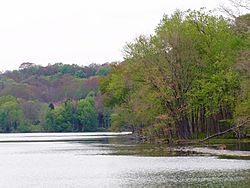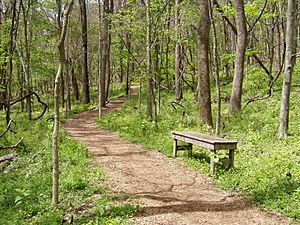Radnor Lake State Natural Area facts for kids
Quick facts for kids Radnor Lake State Natural Area |
|
|---|---|

Radnor Lake
|
|
| Type | Tennessee State Park |
| Location | Oak Hill, Davidson County, Tennessee |
| Area | 1,332 acres (5.39 km2) |
| Created | 1973 |
| Operated by | TDEC |
Radnor Lake State Natural Area, also known as Radnor Lake State Park, is a popular nature preserve. It is located in Oak Hill, near Nashville. This special park is a great place to explore nature.
The preserve covers about 1,368 acres (554 km2). It has five miles of unpaved trails that wind through the woods. Otter Creek Road, which runs through the park, is now closed to cars. Visitors can see many animals native to Middle Tennessee. These include river otters, beavers, mink, muskrat, bobcat, coyote, and white-tailed deer. There is also a visitor's center open from Thursday to Monday.
Contents
Discovering Radnor Lake's Past
Radnor Lake was created in 1914 by the Louisville and Nashville Railroad Company. It was first used to get water for steam trains. It also supplied water for pens where livestock were kept before being shipped. Later, it became a private club for railroad executives and their guests.
Efforts to protect the Radnor Lake area began early. In 1923, a railroad executive declared the site a "Wildlife Sanctuary." This was requested by the Tennessee Ornithological Society. Even though the club used the area for fishing, they also loved its natural beauty.
In 1962, the land was sold for development. But building there was difficult. People also wanted the area to be saved. Because of this public pressure, the state bought the property in 1973. This created Tennessee's very first Natural Area.
It is important to know that hunting is not allowed anywhere in this natural area. Radnor Lake State Natural Area is a Class II State Natural Area. This means it is only for day use. You cannot camp or have picnics there.
Fun Things to Do at Radnor Lake
Exploring Trails
Radnor Lake has many miles of hiking trails. Some trails are easy, and others are more challenging. They are perfect for walking and enjoying nature.
Watching Birds
Many different kinds of birds can be seen at the park. You might spot various duck species, like ring-necked ducks or canvasbacks.
The Barbara J. Mapp Aviary Education Center is also at the park. This center cares for injured birds that cannot return to the wild. You can see amazing birds there, including a great horned owl, a red-tailed hawk, a black vulture, a golden eagle, and bald eagles.



